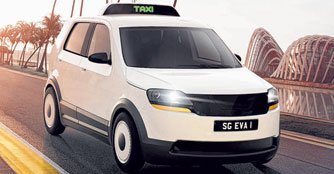Features of the 'Made in Singapore' electric taxi
12 May 2015|2,822 views
Two universities have worked together to develop an electric taxi that works well in tropical cities and could help the country to combat climate change. It was designed and built by TUM Create and is known as EVA.

The taxi has an overhead air-conditioning system that cools individual seats, so air-conditioning for unoccupied zones can be switched off to reduce energy wastage. It also has fans in the seats that wick away heat and moisture, thus reducing the reliance on air-conditioning.
Most parents do not bring their own child seats when travelling in taxis with their young ones. In EVA, the back of the front seat can be folded down to act as a child seat, thus allowing children aged nine months to three years to travel more safely.
Batteries make up a huge chunk of the final cost of an electric car, but they are getting cheaper. They now cost around US$500 a kilowatt-hour, a 60 percent drop from 2010.
Apart from cost, having enough charging stations is another key factor. For EVA, Singapore's more than 70 existing charging stations may need to be retrofitted.
These two factors, cost and accessibility, will probably be the most crucial elements. If mass adoption takes off, this technology will enter a virtuous cycle that could lead to lower prices and a lower carbon footprint.
Two universities have worked together to develop an electric taxi that works well in tropical cities and could help the country to combat climate change. It was designed and built by TUM Create and is known as EVA.
Conventional electric vehicles take six to eight hours to charge and usually cover up to 160km on a full charge. But EVA has a 200km range, travel up to 111km/h and takes just 15 minutes to charge.
The taxi has an overhead air-conditioning system that cools individual seats, so air-conditioning for unoccupied zones can be switched off to reduce energy wastage. It also has fans in the seats that wick away heat and moisture, thus reducing the reliance on air-conditioning.
Most parents do not bring their own child seats when travelling in taxis with their young ones. In EVA, the back of the front seat can be folded down to act as a child seat, thus allowing children aged nine months to three years to travel more safely.
Batteries make up a huge chunk of the final cost of an electric car, but they are getting cheaper. They now cost around US$500 a kilowatt-hour, a 60 percent drop from 2010.
Apart from cost, having enough charging stations is another key factor. For EVA, Singapore's more than 70 existing charging stations may need to be retrofitted.
These two factors, cost and accessibility, will probably be the most crucial elements. If mass adoption takes off, this technology will enter a virtuous cycle that could lead to lower prices and a lower carbon footprint.
Latest COE Prices
April 2025 | 2nd BIDDING
NEXT TENDER: 07 May 2025
CAT A$99,500
CAT B$117,003
CAT C$65,001
CAT E$118,001
View Full Results Thank You For Your Subscription.

















